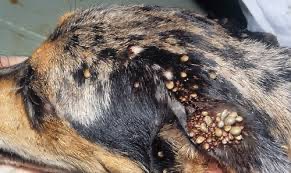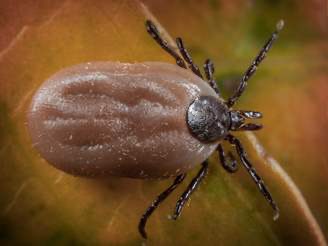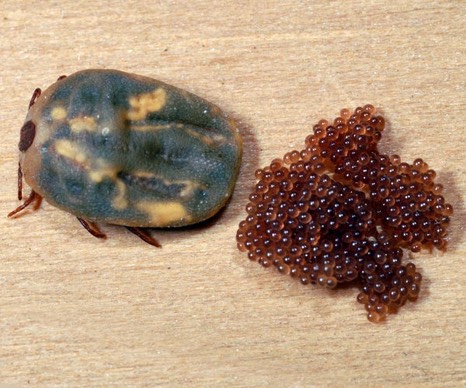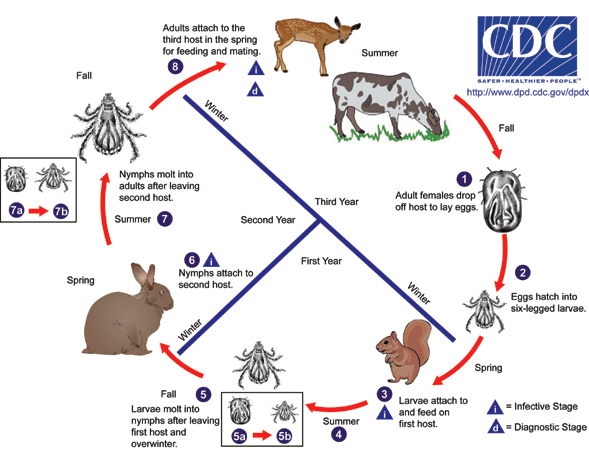Requires Special Treatment Methods
We will learn about the Biology of the tick and specifically the Hard Ticks in the (Family Ixodidea) The Brown Dog Tick
Brown Dog Tick

The brown dog tick is not only a pest of dogs but very often is an unbearable nuisance in the home. Adults of this species generally reside in the ears and between the toes of the dog, while the larvae or “seed ticks” as well as nymphs, are found in the long hair along the back. Heavy infestations on an animal can greatly reduce the animal’s vitality as well as making it irritable.

This tick is not a normal resident of wooded areas and fields; its habitat occurs wherever domestic dogs are found. Dogs do not acquire brown dog ticks directly from other dogs, however. Each active stage, after engorging, drops from the animal, either to molt or to lay eggs. Host pick up ticks from an infested residence, kennel, veterinarian’s office etc. In our area hosts may pick up brown dog ticks from premises surrounding buildings. This specific tick cannot survive outdoors in the colder northern parts of the state.

An engorged female lays from a few hundred to more than 5,000 eggs in cracks and crevices, carpeting, beneath baseboards, and beneath loose plaster or other wall coverings.
The Rocky Mountain wood tick, American dog tick, Long Star tick, Western Backlogged tick, and Backlogged tick are not generally considered house hold pests, but often occur in the vicinity of homes, especially home sites being rapidly carved out of fields and forests of suburban North America. Because they often crawl about for several hours before attaching, these ticks may be carried into a home on pets or clothing. It is then possible for the ticks to attach to a human or pet residing inside the building, causing a potential pest problem.
Nymphs are 1.14 to 1.30 mm in length and 0.57 to 0.66 mm in width, while adults are 2.28 to 3.18 mm in length and 1.11 to 1.68 mm in width. Nymphs and adults are reddish-brown in color with an elongated body shape and do not have ornamentation (markings) on the back
Comparative sizes of ticks

Life Cycle of the (Family Iodide) Tick
There are actually 4 different cycles dependent on the species.
- One-host ixodid tick life cycle
- Two-host ixodid tick life cycle
- Three-host ixodid tick life cycle
- multihost argasid tick life cycle
All self explanatory. Below is the Three-host ixodid tick life cycle

Three-host ixodidae ticks have a life cycle that usually spans three years, although some species can complete the cycle in only two years. Adult females drop off the third host to lay eggs after feeding 1, usually in the fall. Eggs hatch into six-legged larvae 2 and overwinter in the larval stage. In the spring, the larvae seek out and attach to the first host, usually a small rodent 3. Later in the summer, engorged larvae leave the first host 4 and molt into nymphs 5, usually in the fall. The ticks overwinter in this stage. During the following spring, the nymphs seek out and attach to the second host 6, usually another rodent or lagomorph. The nymphs feed on the second host and drop off later in the summer 7. Nymphs molt into adults 7a - 7b off the host in the late summer or fall, and overwinter in this stage. The next spring, adults seek out and attach to a third host, which is usually a larger herbivore (including cervids and bovids), carnivore, or human 8. The adults feed and mate on the third host during the summer. Females drop off the host in the fall to continue the cycle. Females may reattach and feed multiple times. The three hosts do not necessarily have to be different species, or even different individuals. Also, humans may serve as first, second or third hosts.
Ticks in general during this feeding are known vectors for, and could include any of the following:
- Amblyomma (tularemia, ehrlichiosis, Rocky Mountain spotted fever (RMSF), and boutonneuse fever);
- Dermacentor (RMSF, Colorado tick fever, tularemia, Siberian tick typhus, and Central European tick-borne encephalitis, as well as being an agent of tick paralysis);
- Hyalomma (Siberian tick typhus, Crimean-Congo hemorrhagic fever);
- Ixodes (Lyme disease, babesiosis, human granulocytic ehrlichiosis, and Russian spring-summer encephalitis);
- Rhipicephalus (RMSF and boutonneuse fever);
- Ornithodoros (tick-borne relapsing fever);
- Carios (tick-borne relapsing fever).
Prevention of Ticks
As with flea infestation the most common factors are.
- Keep pets treated for fleas and ticks. There are many products on the market to prevent fleas and tick from attaching to your pet.
- Foliage and debris in and around the properties produce safety from sun and heat and provides moisture. Make sure your property is free of loos leaf litter and foliage on the ground and remove.
- Compost near pet areas and home. Keep them away from home and pets.
- Keeping opossums, raccoons, rats, mice etc. from establishing safe harborage in and or around your home.
- Keep lawn at a reasonable length. Ungroomed lawns and high grass provides shade and safe harborage.
- In the home keep clutter under control.
Hiring Pest Management Professionals
Getting a pest management professional (PMP) involved as soon as possible rather than taking time to try to treat the problem yourself, they are very effective at preventing further infestations. Each pest management company should have instructions for residents on how to prepare for the treatment.